Multipurpose Use of Artificial Channel Networks for Flood Risk Reduction: The Case of the Waterway Padova–Venice (Italy)
Abstract
1. Introduction
2. Materials and Methods
2.1. The Brenta–Bacchiglione River System
2.1.1. The S. Gregorio-Piovego Flood Canal and the Voltabarozzo Control Structure
2.2. The Padova–Venezia Waterway
2.2.1. Some Historical Notes
2.2.2. The Waterway Padova–Venice as a Flood Mitigation Structure
2.3. The 2DEF Hydrodynamic Model
2.4. The Computational Domain
Schematization of the Waterway
3. Results and Discussion
3.1. The Role of Waterway as Diversion Canal: Steady-Flow Preliminary Analysis
3.2. The Role of Waterway as a Diversion Canal: Real Flood Waves Routing
3.3. Additional Considerations
4. Conclusions
Author Contributions
Funding
Conflicts of Interest
References
- European Environmental Agency. Mapping the Impacts of Natural Hazards and Technological Accidents in Europe; European Environmental Agency: Kobenhavn, Denmark, 2010. [Google Scholar]
- Arnell, N.W.; Gosling, S.N. The impacts of climate change on river flood risk at the global scale. Clim. Chang. 2016, 134, 387–401. [Google Scholar] [CrossRef]
- Ward, P.J.; Jongman, B.; Aerts, J.C.J.H.; Bates, P.D.; Botzen, W.J.W.; Diaz Loaiza, A.; Hallegatte, S.; Kind, J.M.; Kwadijk, J.; Scussolini, P.; et al. A global framework for future costs and benefits of river-flood protection in urban areas. Nat. Clim. Chang. 2017, 7, 642–646. [Google Scholar] [CrossRef]
- Dottori, F.; Szewczyk, W.; Ciscar, J.-C.; Zhao, F.; Alfieri, L.; Hirabayashi, Y.; Bianchi, A.; Mongelli, I.; Frieler, K.; Betts, R.A.; et al. Increased human and economic losses from river flooding with anthropogenic warming. Nat. Clim. Chang. 2018, 8, 781–786. [Google Scholar] [CrossRef]
- Orlandini, S.; Moretti, G.; Albertson, J.D. Evidence of an emerging levee failure mechanism causing disastrous floods in Italy. Water Resour. Res. 2015, 51, 7995–8011. [Google Scholar] [CrossRef]
- Slater, L.J. To what extent have changes in channel capacity contributed to flood hazard trends in England and Wales? Earth Surf. Process. Landf. 2016, 41, 1115–1128. [Google Scholar] [CrossRef]
- Vacondio, R.; Aureli, F.; Ferrari, A.; Mignosa, P.; Dal Palù, A. Simulation of the January 2014 flood on the Secchia river using a fast and high-resolution 2D parallel shallow-water numerical scheme. Nat. Hazards 2016, 80, 103–125. [Google Scholar] [CrossRef]
- Viero, D.P.; D’Alpaos, A.; Carniello, L.; Defina, A. Mathematical modeling of flooding due to river bank failure. Adv. Water Resour. 2013, 59, 82–94. [Google Scholar] [CrossRef]
- Kundzewicz, Z.W.; Kanae, S.; Seneviratne, S.I.; Handmer, J.; Nicholls, N.; Peduzzi, P.; Mechler, R.; Bouwer, L.M.; Arnell, N.; Mach, K.; et al. Flood risk and climate change: Global and regional perspectives. Hydrol. Sci. J. 2014, 59, 1–28. [Google Scholar] [CrossRef]
- Slater, L.J.; Singer, M.B.; Kirchner, J.W. Drivers of flood hazard. Geophys. Res. Lett. 2015, 42, 370–376. [Google Scholar] [CrossRef]
- Slater, L.J.; Villarini, G. Recent trends in U.S. flood risk. Geophys. Res. Lett. 2016, 43, 12428–12436. [Google Scholar] [CrossRef]
- Viero, D.P.; Roder, G.; Matticchio, B.; Defina, A.; Tarolli, P. Floods, landscape modifications and population dynamics in anthropogenic coastal lowlands: The Polesine (northern Italy) case study. Sci. Total Environ. 2019, 651, 1435–1450. [Google Scholar] [CrossRef] [PubMed]
- Rayment, M.; Conway, M.; Batrakova, S.; McNeil, D.; Christie, M.; Remoundou, K. Estimating the Impact on Public Benefits from Changes in Investment in the Environment Agency Waterways; Technical Report; ICF GHK: London, UK, 2014. [Google Scholar]
- Galil, B.S.; Nehring, S.; Panov, V. Waterways as invasion highways-impact of climate change and globalization. In Biological Invasions; Springer: Berlin/Heidelberg, Germany, 2007; pp. 59–74. [Google Scholar]
- Rose, C.B.; Walker, L. Inland waterway systems-a solution to drought and flooding issues. In Water Resources in the Built Environment; John Wiley & Sons Ltd.: Chichester, UK, 2014; pp. 180–195. [Google Scholar]
- Ionescu, R.-V. Inland waterways’ importance for the European economy. Case study: Romanian inland Waterways transport. J. Danub. Stud. Res. 2016, 6, 207–2019. [Google Scholar]
- Martini, P.; Carniello, L.; Avanzi, C. Two dimensional modelling of flood flows and suspended sedimenttransport: The case of the Brenta river, Veneto (Italy). Nat. Hazards Earth Syst. Sci. 2004, 4, 165–181. [Google Scholar] [CrossRef]
- Zanetti, P.G. Acque di Padova. 150 Anni del Canale Scaricatore; Cierre Editore: Verona, Italy, 2013; ISBN 9788883147265. [Google Scholar]
- Mazzoleni, M.; Verlaan, M.; Alfonso, L.; Monego, M.; Norbiato, D.; Ferri, M.; Solomatine, D.P. Can assimilation of crowdsourced data in hydrological modelling improve flood prediction? Hydrol. Earth Syst. Sc. 2017, 21, 839–861. [Google Scholar] [CrossRef]
- Viero, D.P. Comment on “Can assimilation of crowdsourced data in hydrological modelling improve flood prediction?” by Mazzoleni et al. (2017). Hydrol. Earth Syst. Sci. 2018, 22, 171–177. [Google Scholar] [CrossRef]
- Mozzi, P.; Piovan, S.; Rossato, S.; Cucato, M.; Abbà, T.; Fontana, A. Palaeohydrography and early settlements in Padua (Italy). Quat. Ital. J. Quat. Sci. 2010, 23, 387–400. [Google Scholar]
- Prosdocimi, M.; Fontana, D.G.; Tarolli, P.; Giupponi, C.; Bojovic, D. Pilot Activities in Brenta River Basin (Italy); Technical Report; University of Padua, Department Tesaf, Veneto Region, Cà Foscari University of Venice, Department of Economics: Venice, Italy, 2014. [Google Scholar]
- Moretto, J.; Delai, F.; Lenzi, M.A. Hybrid DTMS derived by lidar and colour bathymetry for assessing fluvial geomorphic changes after flood events in gravel-bed rivers (Tagliamento, Piave and Brenta rivers, Italy). Int. J. Saf. Secur. Eng. 2013, 3, 128–140. [Google Scholar] [CrossRef]
- D’Alpaos, L. Fatti e Misfatti di Idraulica Lagunare. La Laguna di Venezia Dalla Diversione dei Fiumi Alle Nuove Opere Alle Bocche di Porto; Istituto Veneto di SS.LL.AA., Memorie, Classe di Scienze Fisiche, Matematiche e Naturali: Venezia, Italy, 2010; Volume 44. [Google Scholar]
- Mel, R.; Viero, D.P.; Carniello, L.; D’Alpaos, L. Optimal floodgate operation for river flood management: The case study of Padova (Italy). J. Hydrol. Reg. Stud. accepted.
- Alfieri, L.; Bisselink, B.; Dottori, F.; Naumann, G.; de Roo, A.; Salamon, P.; Wyser, K.; Feyen, L. Global projections of river flood risk in a warmer world. Earth’s Futur. 2017, 5, 171–182. [Google Scholar] [CrossRef]
- Blöschl, G.; Hall, J.; Viglione, A.; Perdigão, R.A.P.; Parajka, J.; Merz, B.; Lun, D.; Arheimer, B.; Aronica, G.T.; Bilibashi, A.; et al. Changing climate both increases and decreases European river floods. Nature 2019, 573, 108–111. [Google Scholar] [CrossRef]
- Mel, R.; Sterl, A.; Lionello, P. High resolution climate projection of storm surge at the Venetian coast. Nat. Hazards Earth Syst. Sci. 2013, 13, 1135–1142. [Google Scholar] [CrossRef][Green Version]
- Miller, J.D.; Hutchins, M. The impacts of urbanisation and climate change on urban flooding and urban water quality: A review of the evidence concerning the United Kingdom. J. Hydrol. Reg. Stud. 2017, 12, 345–362. [Google Scholar] [CrossRef]
- Pijl, A.; Brauer, C.C.; Sofia, G.; Teuling, A.J.; Tarolli, P. Hydrologic impacts of changing land use and climate in the Veneto lowlands of Italy. Anthropocene 2018, 22, 20–30. [Google Scholar] [CrossRef]
- Sofia, G.; Tarolli, P. Hydrological Response to~30 years of agricultural surface water management. Land 2017, 6, 3. [Google Scholar] [CrossRef]
- D’Alpaos, L.; Defina, A. Venice Lagoon Hydrodynamics Simulation by Coupling 2D and 1D Finite Element Models, Proceedings of the 8th Conference on Finite Elements in Fluids in New Trends and Applications, Barcelona, Spain, 20–24 September 1993; Morgan, K., Onate, E., Periaux, J., Peraire, J., Zienkiewicz, O., Eds.; Pineridge Press: Barcelona, Spain, 1993; pp. 20–24. [Google Scholar]
- Defina, A.; D’Alpaos, L.; Matticchio, B. A new set of equations for very shallow water and partially dry areas suitable to 2D numerical models. In Modelling Flood Propagation Over Initially Dry Areas; Molinaro, P., Natale, L., Eds.; American Society of Civil Engineers: New York, NY, USA, 1994; pp. 72–81. [Google Scholar]
- Viero, D.P.; Peruzzo, P.; Carniello, L.; Defina, A. Integrated mathematical modeling of hydrological and hydrodynamic response to rainfall events in rural lowland catchments. Water Resour. Res. 2014, 50, 5941–5957. [Google Scholar] [CrossRef]
- Viero, D.P.; Defina, A. Water age, exposure time, and local flushing time in semi-enclosed, tidal basins with negligible freshwater inflow. J. Mar. Syst. 2016, 156, 16–29. [Google Scholar] [CrossRef]
- Defina, A. Two-dimensional shallow flow equations for partially dry areas. Water Resour. Res. 2000, 36, 3251. [Google Scholar] [CrossRef]
- Viero, D.P. Modelling urban floods using a finite element staggered scheme with an anisotropic dual porosity model. J. Hydrol. 2019, 568, 247–259. [Google Scholar] [CrossRef]
- Stansby, P.K. A mixing-length model for shallow turbulent wakes. J. Fluid Mech. 2003, 495, 369–384. [Google Scholar] [CrossRef]
- Uittenbogaard, R.; van Vossen, B. Subgrid-scale model for quasi-2D turbulence in shallow water. In Shallow Flows; Taylor & Francis: Abingdon, UK, 2004; pp. 575–582. [Google Scholar]
- Defina, A. Numerical experiments on bar growth. Water Resour. Res. 2003, 39, 1–12. [Google Scholar] [CrossRef]
- Giraldo, F.X. The Lagrange-Galerkin method for the two-dimensional shallow water equations on adaptive grids. Int. J. Numer. Meth. Fl. 2000, 33, 789–832. [Google Scholar] [CrossRef]
- Walters, R.A.; Casulli, V. A robust, finite element model for hydrostatic surface water flows. Commun. Numer. Meth. Engng. 1998, 14, 931–940. [Google Scholar] [CrossRef]
- D’Alpaos, L.; Defina, A.; D’Alpaos, L.; Defina, A. Mathematical modeling of tidal hydrodynamics in shallow lagoons: A review of open issues and applications to the Venice Lagoon. Comput. Geosci. 2007, 33, 476–496. [Google Scholar] [CrossRef]
- Cunge, J.A.; Wegner, M. Numerical integration of Barré de Saint-Venant’s flow equations by means of an implicite scheme of finite differences. Houille Blanche 1964, 1, 33–39. [Google Scholar] [CrossRef]
- Viero, D.P.; Valipour, M. Modeling anisotropy in free-surface overland and shallow inundation flows. Adv. Water Resour. 2017, 104, 1–14. [Google Scholar] [CrossRef]
- D’Alpaos, L.; Defina, A.; Matticchio, B. A Coupled 2D and 1D Finite Element Model for Simulating Tidal Flow in the Venice Channel Network, Proceedings of the Ninth International Conference on Finite Elements in Fluids New Trends and Applications, Venezia, Italy, 15–21 October 1995; Morandi Cecchi, M., Morgan, K., Periaux, J., Schrefler, B.A., Zienkiewicz, O.C., Eds.; SM Legatoria: Venezia, Italy, 1995; pp. 1397–1406. [Google Scholar]
- Viero, D.P.; Defina, A. Extended theory of hydraulic hysteresis in open-channel flow. J. Hydraul. Eng. 2017, 143, 06017014. [Google Scholar] [CrossRef]
- Viero, D.P.; Defina, A. Multiple states in the flow through a sluice gate. J. Hydraul. Res. 2019, 57, 39–50. [Google Scholar] [CrossRef]
- Viero, D.P.; Peruzzo, P.; Defina, A. Positive surge propagation in sloping channels. Water 2017, 9, 518. [Google Scholar] [CrossRef]
- Viero, D.P.; Defina, A. Consideration of the mechanisms for tidal bore formation in an idealized planform geometry. Water Resour. Res. 2018, 54, 5670–5686. [Google Scholar] [CrossRef]
- Defina, A.; Susin, F.M.; Viero, D.P. Numerical study of the Guderley and Vasilev reflections in steady two-dimensional shallow water flow. Phys. Fluids 2008, 20. [Google Scholar] [CrossRef]
- Defina, A.; Susin, F.M.; Viero, D.P. Bed friction effects on the stability of a stationary hydraulic jump in a rectangular upward sloping channel. Phys. Fluids 2008, 20. [Google Scholar] [CrossRef]
- Defina, A.; Viero, D.P. Open channel flow through a linear contraction. Phys. Fluids 2010, 22. [Google Scholar] [CrossRef]
- Guinot, V. Multiple porosity shallow water models for macroscopic modelling of urban floods. Adv. Water Resour. 2012, 37, 40–72. [Google Scholar] [CrossRef]
- Viero, D.P.; Susin, F.M.; Defina, A. A note on weak shock wave reflection. Shock Waves 2013, 23, 505–511. [Google Scholar] [CrossRef]
- Ferrari, A.; Viero, D.P. Floodwater pathways in urban areas: A method to compute porosity fields for anisotropic subgrid models in differential form. J. Hydrol. under review.
- Viero, D.P.; Lopez Dubon, S.; Lanzoni, S. Chute cutoffs in meandering rivers: Formative mechanisms and hydrodynamic forcing. In Fluvial Meanders and Their Sedimentary Products in the Rock Record (IAS SP 48); Ghinassi, M., Colombera, L., Mountney, N., Reesink, A.J.H., Eds.; John Wiley & Sons: Hoboken, NJ, USA, 2018; pp. 201–230. [Google Scholar]
- Marani, M.; D’Alpaos, A.; Lanzoni, S.; Carniello, L.; Rinaldo, A. Biologically-controlled multiple equilibria of tidal landforms and the fate of the Venice lagoon. Geophys. Res. Lett. 2007, 34, L11402. [Google Scholar] [CrossRef]
- Carniello, L.; Defina, A.; D’Alpaos, L. Morphological evolution of the Venice lagoon: Evidence from the past and trend for the future. J. Geophys. Res. 2009, 114, F04002. [Google Scholar] [CrossRef]
- Bendoni, M.; Mel, R.; Solari, L.; Lanzoni, S.; Francalanci, S.; Oumeraci, H. Insights into lateral marsh retreat mechanism through localized field measurements. Water Resour. Res. 2016, 52, 1446–1464. [Google Scholar] [CrossRef]
- Sarretta, A.; Pillon, S.; Molinaroli, E.; Guerzoni, S.; Fontolan, G. Sediment budget in the lagoon of Venice, Italy. Cont. Shelf Res. 2010, 30, 934–949. [Google Scholar] [CrossRef]
- Tommasini, L.; Carniello, L.; Ghinassi, M.; Roner, M.; D’Alpaos, A. Changes in the wind-wave field and related salt-marsh lateral erosion: Inferences from the evolution of the Venice lagoon in the last four centuries. Earth Surf. Process. Landf. 2019, 44, 1633–1646. [Google Scholar] [CrossRef]
- Rinaldo, A.; Nicótina, L.; Alessi Celegon, E.; Beraldin, F.; Botter, G.; Carniello, L.; Cecconi, G.; Defina, A.; Settin, T.; Uccelli, A.; et al. Sea level rise, hydrologic runoff, and the flooding of Venice. Water Resour. Res. 2008, 44. [Google Scholar] [CrossRef]
- Mel, R.; Carniello, L.; D’Alpaos, L. Addressing the effect of the Mo.S.E. barriers closure on wind setup within the Venice lagoon. Estuar. Coast. Shelf Sci. 2019, 225, 106249. [Google Scholar] [CrossRef]
- Mel, R.; Carniello, L.; D’Alpaos, L. Dataset of wind setup in a regulated Venice lagoon. Data Br. 2019, 26, 104386. [Google Scholar] [CrossRef]
- Mel, R.; Viero, D.P.; Carniello, L.; Defina, A.; D’Alpaos, L. Simplified methods for real-time prediction of storm surge uncertainty: The city of Venice case study. Adv. Water Resour. 2014, 71, 177–185. [Google Scholar] [CrossRef]
- Mel, R.; Lionello, P. Probabilistic dressing of a storm surge prediction in the Adriatic sea. Adv. Meteorol. 2016, 2016, 1–8. [Google Scholar] [CrossRef]
- Chen, C.; Liu, H.; Beardsley, R.C. An Unstructured grid, finite-volume, three-dimensional, primitive equations ocean model: Application to coastal ocean and estuaries. J. Atmos. Ocean. Technol. 2003, 20, 159–186. [Google Scholar] [CrossRef]
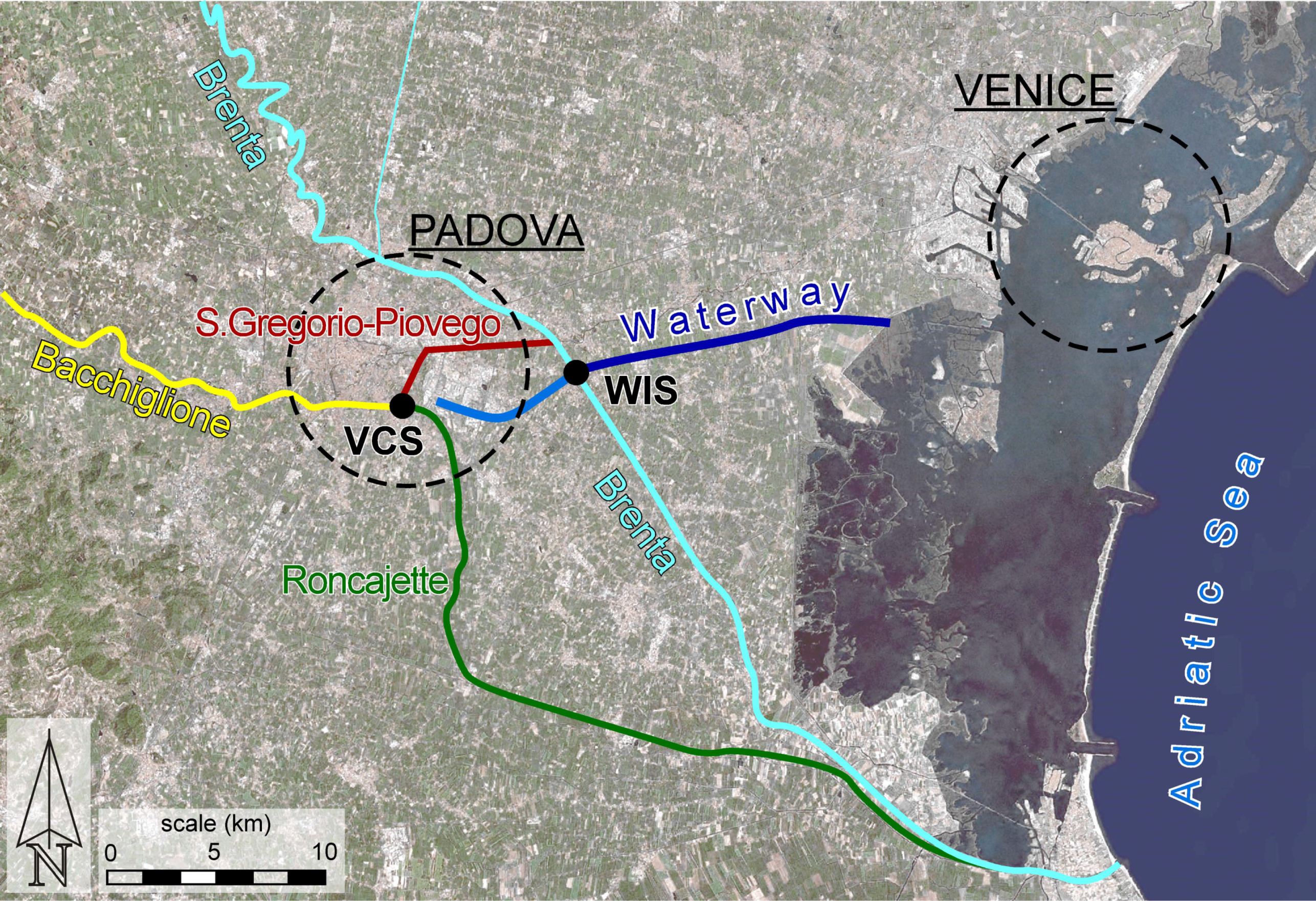
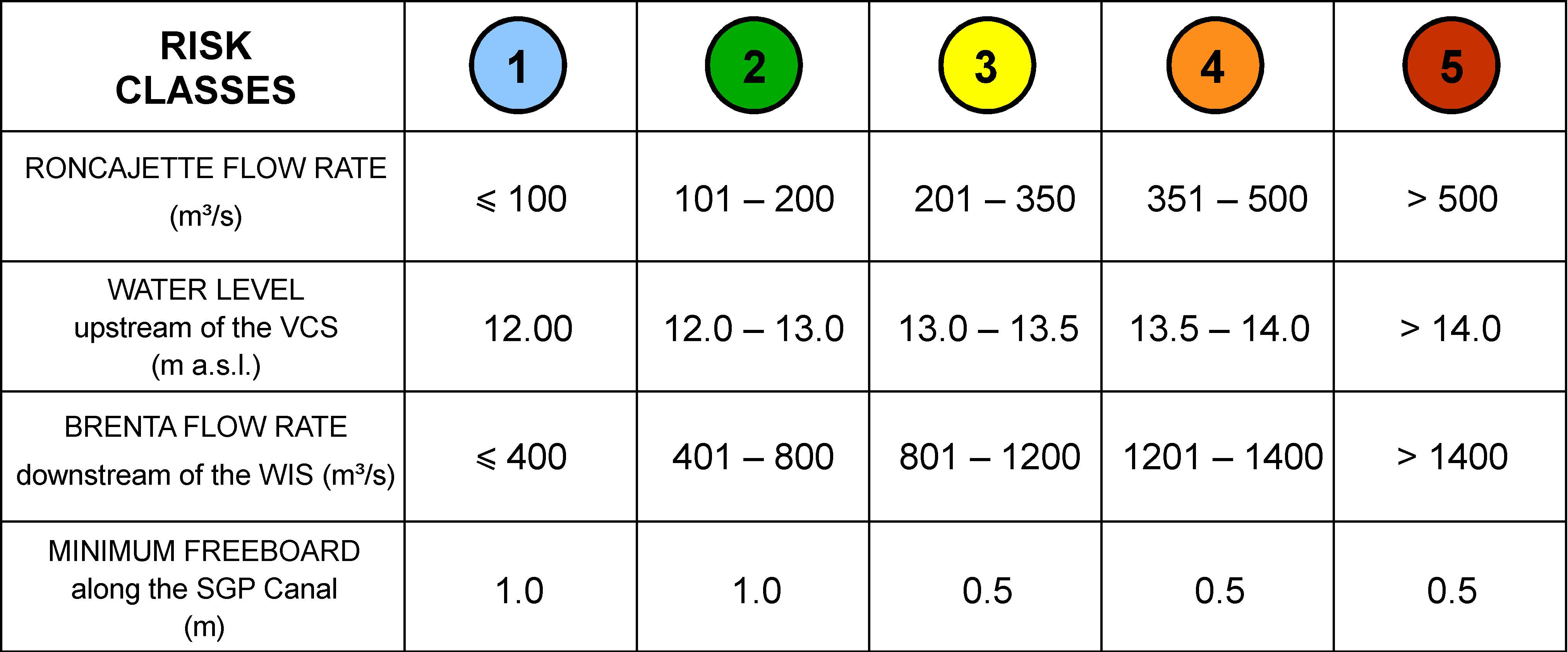
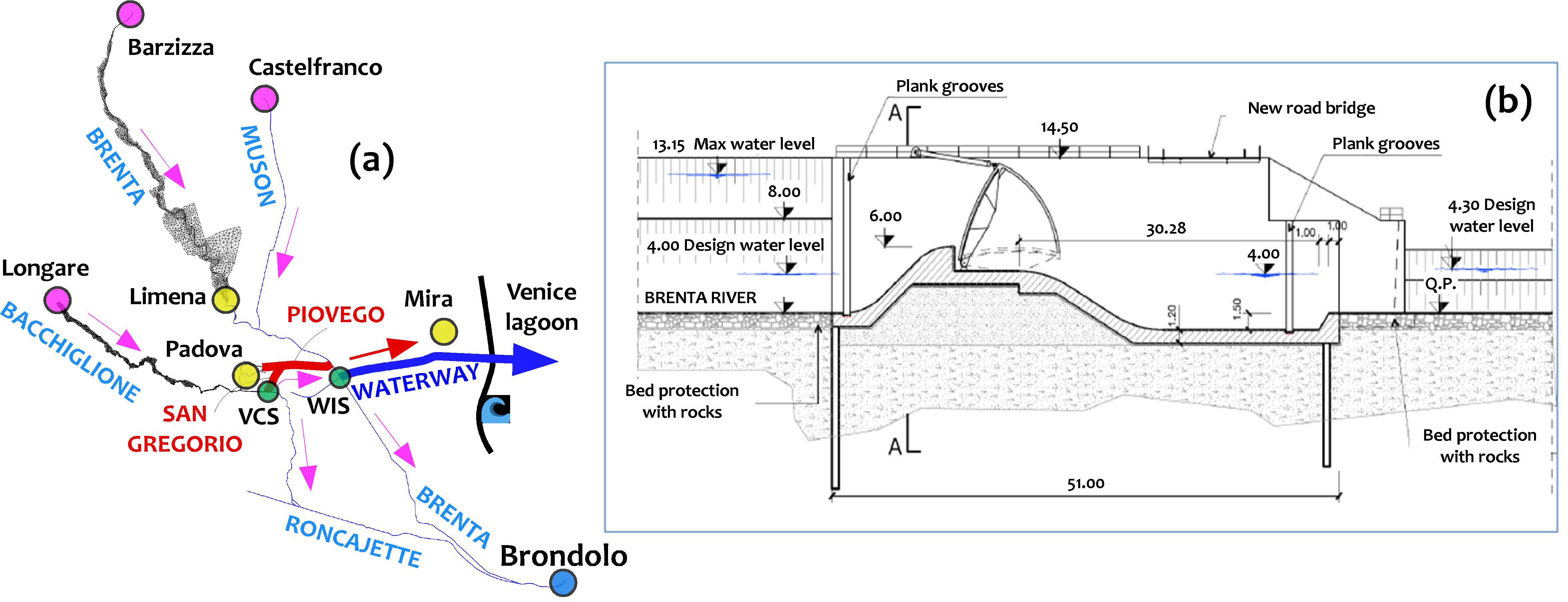
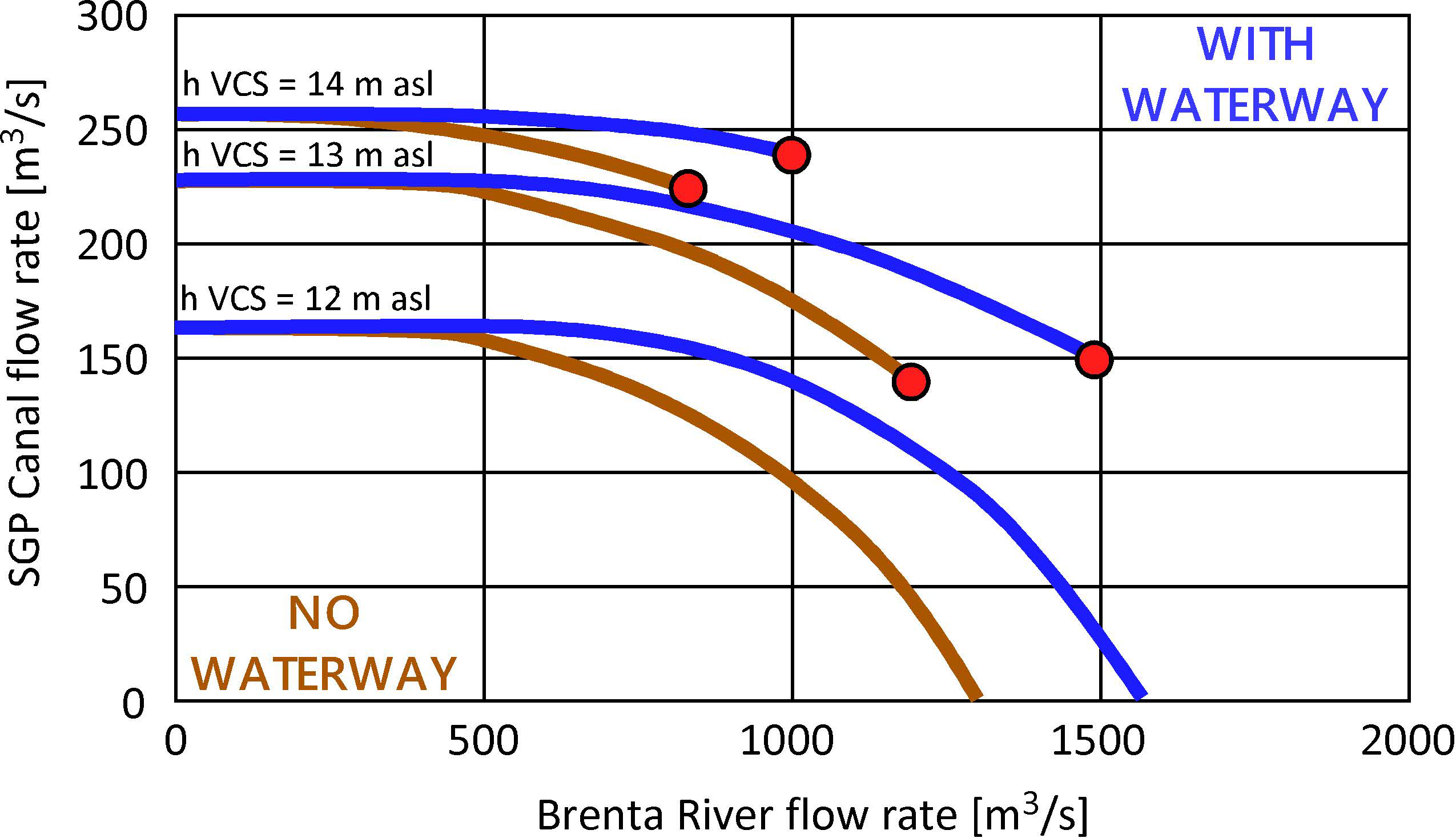

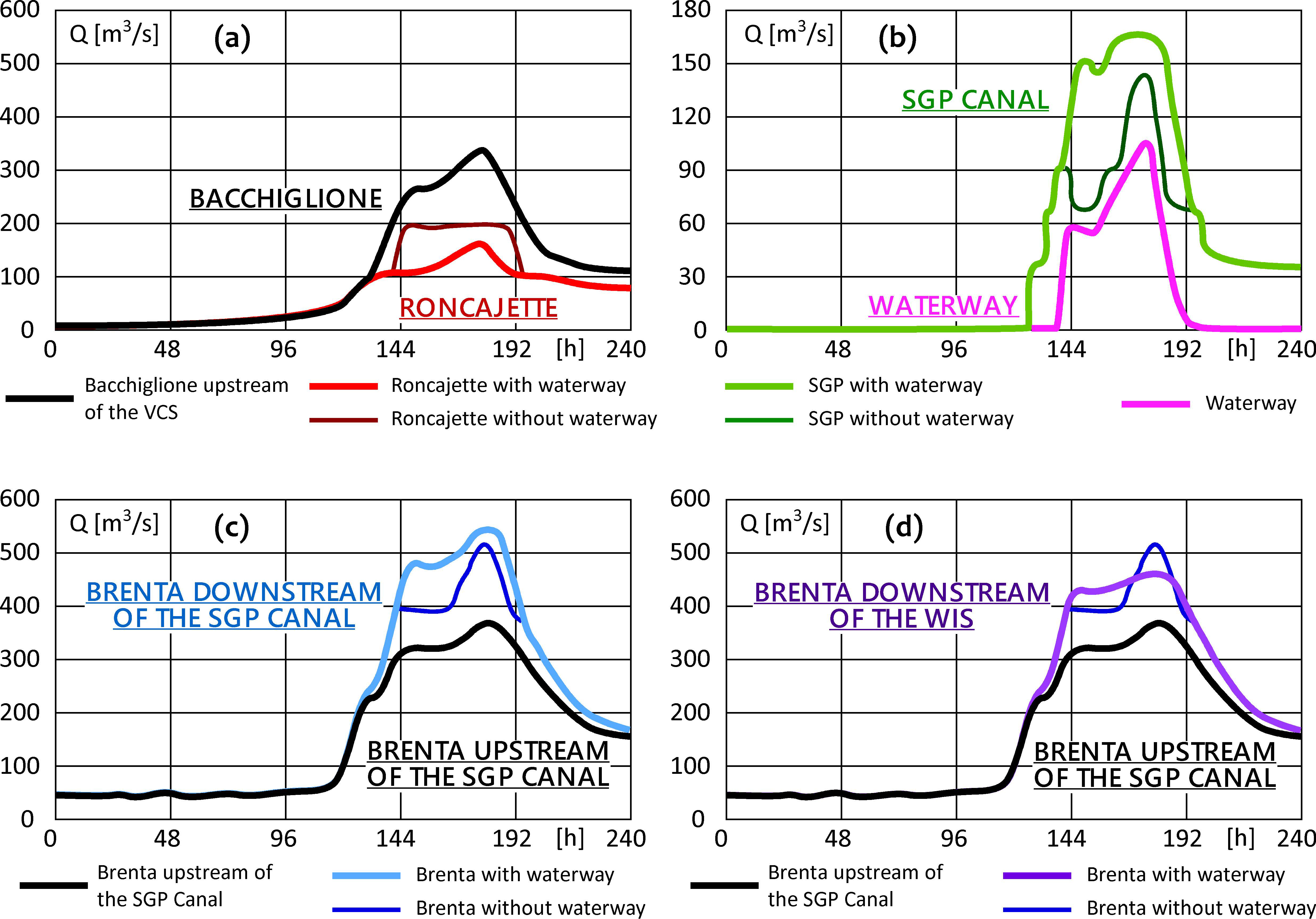
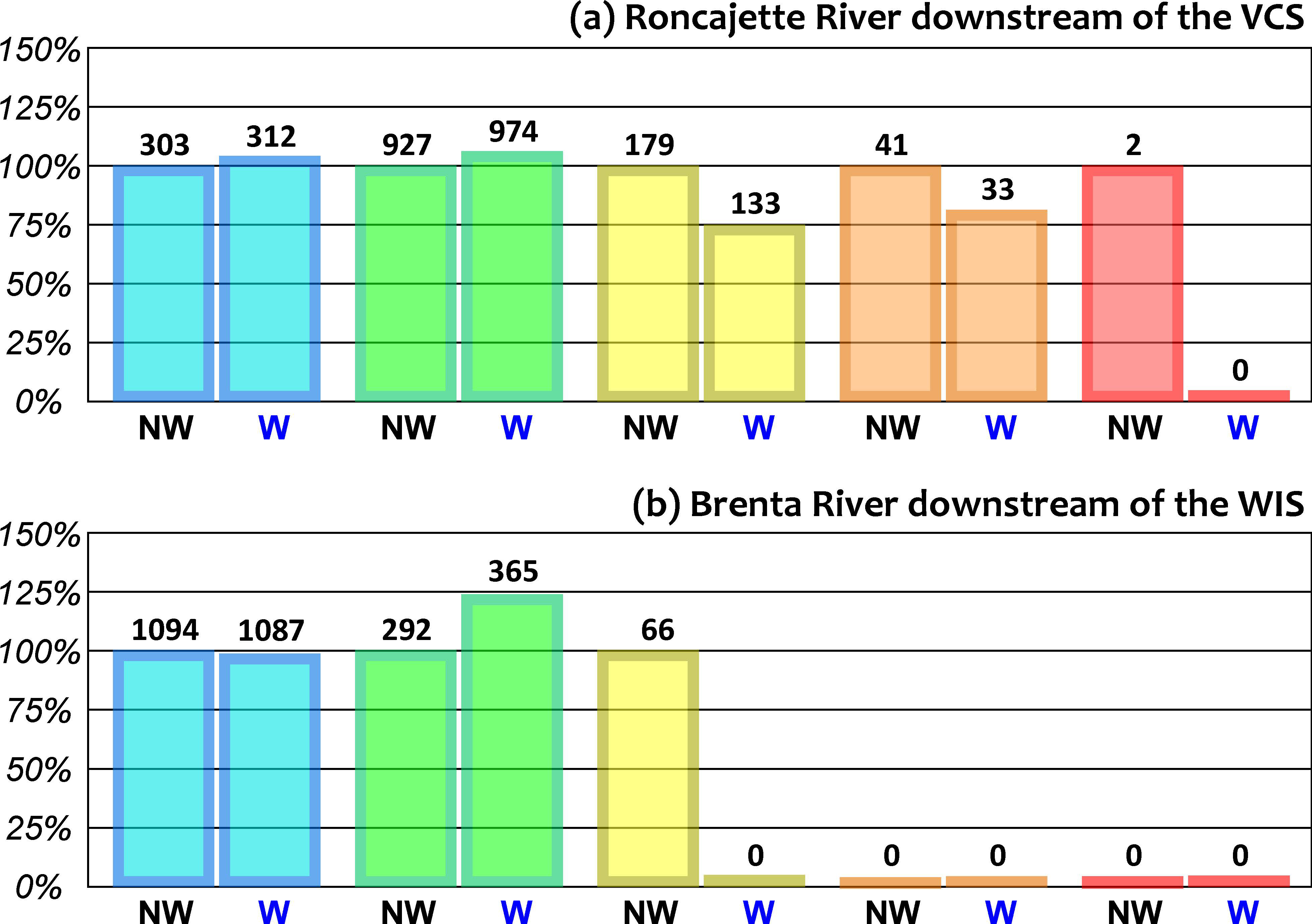
| n of Event | Begin | End |
|---|---|---|
| 1 | 2 February 2009 | 10 February 2009 |
| 2 | 22 April 2009 | 2 May 2009 |
| 3 | 18 December 2010 | 28 December 2010 |
| 4 | 1 November 2011 | 10 November 2011 |
| 5 | 11 May 2013 | 21 May 2013 |
| 6 | 25 January 2014 | 8 February 2014 |
© 2020 by the authors. Licensee MDPI, Basel, Switzerland. This article is an open access article distributed under the terms and conditions of the Creative Commons Attribution (CC BY) license (http://creativecommons.org/licenses/by/4.0/).
Share and Cite
Mel, R.A.; Viero, D.P.; Carniello, L.; D’Alpaos, L. Multipurpose Use of Artificial Channel Networks for Flood Risk Reduction: The Case of the Waterway Padova–Venice (Italy). Water 2020, 12, 1609. https://doi.org/10.3390/w12061609
Mel RA, Viero DP, Carniello L, D’Alpaos L. Multipurpose Use of Artificial Channel Networks for Flood Risk Reduction: The Case of the Waterway Padova–Venice (Italy). Water. 2020; 12(6):1609. https://doi.org/10.3390/w12061609
Chicago/Turabian StyleMel, Riccardo Alvise, Daniele Pietro Viero, Luca Carniello, and Luigi D’Alpaos. 2020. "Multipurpose Use of Artificial Channel Networks for Flood Risk Reduction: The Case of the Waterway Padova–Venice (Italy)" Water 12, no. 6: 1609. https://doi.org/10.3390/w12061609
APA StyleMel, R. A., Viero, D. P., Carniello, L., & D’Alpaos, L. (2020). Multipurpose Use of Artificial Channel Networks for Flood Risk Reduction: The Case of the Waterway Padova–Venice (Italy). Water, 12(6), 1609. https://doi.org/10.3390/w12061609






